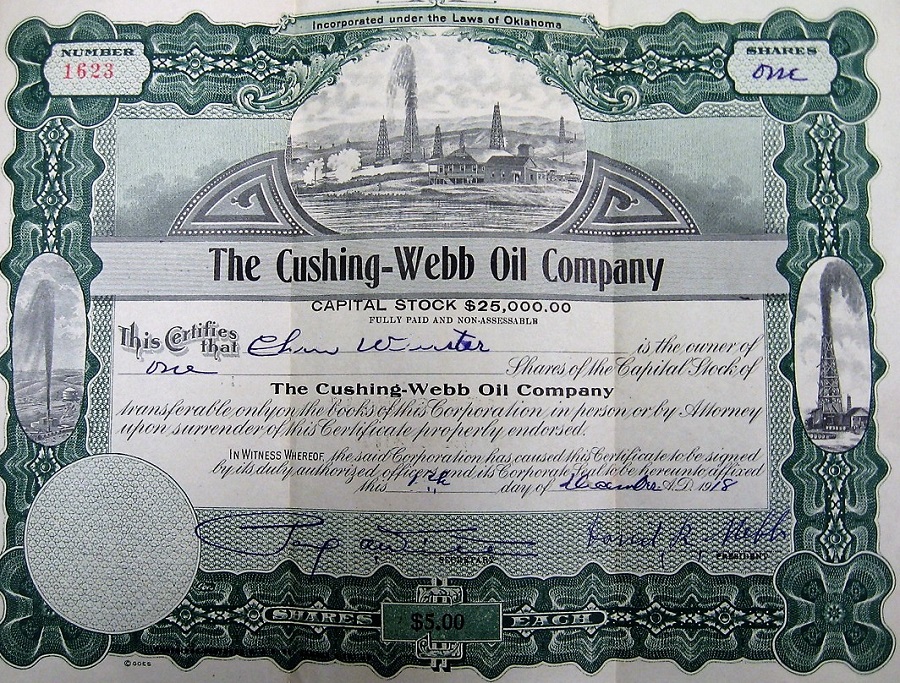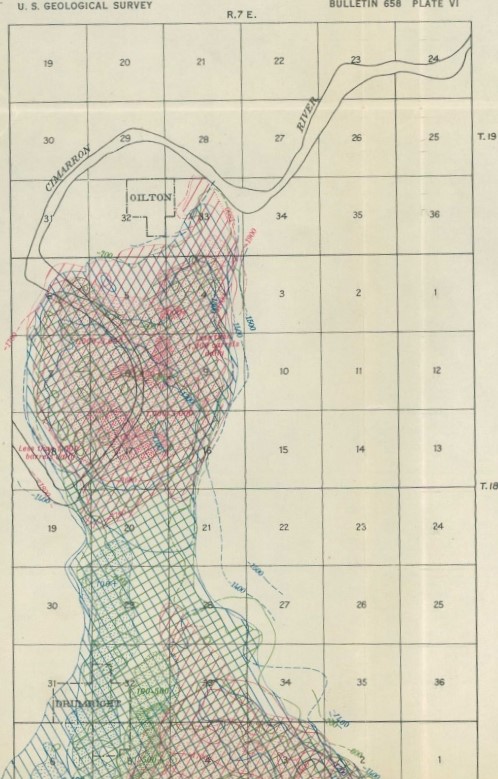Cushing-Webb Oil Company
Mid-continent oilfield discoveries by a famed Oklahoma wildcatter inspired the founding of new exploration companies, many with little experience in the “oil patch.” Most would fail, including the Cushing-Webb Oil Company.
In 1912, Thomas Baker Slick, formerly known as “Dry Hole Slick,” became Oklahoma’s King of the Wildcatters when his Wheeler No. 1 well led him to an oilfield that changed America’s future. Production from his Cushing-Drumright field peaked in May 1915 when 3,090 wells produced 310,000 barrels of oil every day. The field would help fuel the 1918 Allied victory in World War I.
The lure of petroleum wealth was irresistible and investors rushed to the area between Oklahoma City and Tulsa. Newly formed exploration ventures included the Cushing-Webb Oil Company, chartered in Stillwater two months after Slick’s discovery. David R. Webb, Sam Meyers and Paul A. Wintersteen incorporated their company with capital stock of $25,000, according to a report in the Texas Trade Review and Industrial Record. The new company advertised for stock sales agents in the Wichita Daily Eagle:

A 1917 oilfield discovery near Cushing, Oklahoma, by independent oil producer Thomas Slick led to creation of new exploration companies, some with dubious promises of oil riches.
SALESMEN WANTED – Is there a live-wire salesman who wants to clean up $1,500 or more in the next 90 days? Get in communication with us. We have the best oil lot and stock proposition on the market Cushing field and our literature and commission has every other company beat. We have the proposition to make you a chunk of money. Cushing-Webb Oil Co., Stillwater, Okla.
With elaborate promotions, Cushing-Webb Oil reached out for new investors. The company claimed ownership of a 40-acre tract amidst the vast production of the Cushing-Drumright oilfield. A purchase of one share offered a 400-square-foot lot, and a promise to drill. It would be three years before the company erected a drilling rig.
In his 1979 book Hurry Home Wednesday; Growing Up in a Small Missouri Town, 1905-1921, Loren Reid, recalled a visit from a Cushing-Webb Oil agent:
In the Spring of 1917, a nice-appearing soft-spoken man in his late 30s stepped off the train from Kansas City and checked in at the Harmon, no doubt delighting the innkeeper with the information that he planned to stay a few days. From there he fanned out into our Miracle Mile, starting with the professional men and moving on to the merchants, introducing himself as a representative of the Cushing-Webb Oil Company of Oklahoma.
The stranger told an exciting story of the millions to be made in oil, starting with the narrative of the millions that had already been made in oil. He had a map showing the location of the productive Cushing field with dots indicating the size of its many gushers. The choice acreage that he represented hovered above. As the company’s geologists confidently believed, a seven-thousand barrel a day vein.

Cushing-Webb Oil secured a lease on the Lon McGilbray farm in Creek County and built its first oil rig about five miles northwest of Oilton, across the Cimarron River.
Reid noted that his small town had been prospering and the local newspaper, the Gilman City Guide, was running more and bigger ads than it had for quite a while. “Everybody had a little more money on hand than he was accustomed to. It was a heady feeling,” he explained, before continuing:
And here was Cushing-Webb, offering a chance to get in on the ground floor. To be sure there were risks, dry holes had been dug before and would be again, but then…
Within twenty-four hours the whole business district was aware of the stranger’s visit. Everybody was talking oil. Father and Mother were among those honored by a call. I heard part of the sales talk. Afterwards they conversed excitedly, their spirits exalted. “Just imagine,” Mother said, “if they did strike oil and we made some real money.” Even if they got only five-thousand barrels a day, added Father, “that would be pretty good.” And so on, into the night. What if …just suppose… imagine.
In another twenty-four hours rumors of a different sort flowed through the town like oil through a pipeline. This individual had bought shares, and so had this one, and that one. The rumors were readily confirmed by the proud possessors of the shares. Then at some point, another entirely different line of fantasizing took over: What if Jones bought shares and struck it rich, and we bought no shares and were left out? Here was a thought to make strong men and women shudder. No one with idle money could look such an outcome squarely in the face.
When the stranger returned, Father and Mother bought shares.
It took three years of energetic promotion, but by February 1919, Cushing-Webb Oil secured a lease on the Lon McGilbray farm in Creek County, and erected its first oil derrick northest of Cushing, near Oilton (S.W. corner of N.W. quarter of S.E. quarter of Section 19, Township 19 North, Range 7 East). Then nothing.
In April 1919, the trade magazine National Petroleum News was reporting about false advertising claims and other predations of oil stock hucksters. “Aroused to action by complaints of the many victims, local, federal and state authorities are tightening their grip on the stock jobbing charlatans who have mulcted their victims of millions in cash and Liberty Bonds in exchange for worthless stocks. Fake oil promotions schemes figure prominently.”

Despite many promotions over several years, Cushing-Webb Oil constructed only one derrick. No drilling was reported before the company failed.
Meanwhile, between February and July 1919, the Oil and Gas News noted in recurring reports that Cushing-Webb Oil Company’s McGilbray No. 1 well, “is still a rig” with no drilling undertaken and no progress made, but stock sales continued.
The Illinois Secretary of State published a list of 35 oil companies that since January 1919 had been “denied licenses to do business under the Illinois Blue Sky Law,” which regulated the offering and sale of securities to protect the public from fraud. Cushing Webb Oil was on the list, and the company folded along with many other failed oil speculations.
Back in Gilman City, Missouri, author Loren Reid concluded, “Little or no oil was found. Father and Mother were taken to the tune of two or three hundred dollars, which for them was a serious loss.”
________________________________________________________
The stories of many exploration companies trying to join petroleum booms (and avoid busts) can be found in an updated series of research in Is my Old Oil Stock worth Anything?
AOGHS.org welcomes sponsors to help us preserve petroleum history. Please support this energy education website with a contribution today. Contact bawells@aoghs.org for information on levels and types of available sponsorships. © 2018 AOGHS.
.

 Despite the Bristow area’s dry holes between the giant oilfields, Continental Petroleum Company attempted an exploratory well just east of the town. On October 17, 1921, its Ben Sharper No. 1 well was completed with oil production of 1,000 barrels a day. It was the discovery well for what became known as the Continental Pool. The success soon drew many competitors and Bristow’s population soared.
Despite the Bristow area’s dry holes between the giant oilfields, Continental Petroleum Company attempted an exploratory well just east of the town. On October 17, 1921, its Ben Sharper No. 1 well was completed with oil production of 1,000 barrels a day. It was the discovery well for what became known as the Continental Pool. The success soon drew many competitors and Bristow’s population soared.